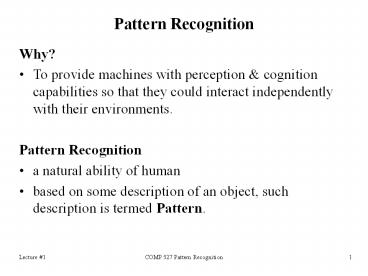Pattern Recognition PowerPoint PPT Presentation
Title: Pattern Recognition
1
Pattern Recognition
- Why?
- To provide machines with perception cognition
capabilities so that they could interact
independently with their environments. - Pattern Recognition
- a natural ability of human
- based on some description of an object, such
description is termed Pattern.
2
Patterns and Pattern Classes
- Almost anything within the reach of our five
senses can be chosen as a pattern - Sensory patterns speech, odors, tastes
- Spatial patterns characters, fingerprints,
pictures - Temporal patterns waveforms, electrocardiograms,
movies - Conceptual recognition for abstract items
- (We will limit ourselves to deal with only
physical objects/ events, but NOT abstract
entities, say, concepts.) - A pattern class is a group of patterns with
certain common characteristics.
3
Pattern Recognition
- Pattern Recognition is the science to assign an
object/event of interest to one of several
prespecified categories/classes based on certain
measurements or observations. - Measurements are usually problem dependent.
- E.g. weight or height for basketball
players/jockeys - color for apples/oranges
- Feature vectors represent measurements as
coordinates of points in a vector space (feature
space).
4
Pattern Recognition Systems
5
Statistical Pattern Recognition
- Taps into the vast and thorough knowledge of
statistics to provide a formal treatment of PR. - Observations are assumed to be generated by a
state of nature - data can be described by a statistical model
- model by a set of probability functions
- Strength many powerful mathematical tools from
the theory of probability and statistics. - Shortcoming it is usually impossible to design
(statistically) errorfree systems.
6
Example OCR
7
Major Steps
8
Raw Features Example
9
Feature Extraction OCR Example
10
Feature Extraction
- Objectives To remove irrelevant information and
extract distinctive, representative information
of the objects. - discriminative
- invariant
- data compression gt dimension reduction
- It is not easy!
11
Data Modeling
- To build statistical models for describing the
data. - Parametric models
- single probability density function e.g.
Gaussian - mixture density function e.g. Gaussian mixture
model (GMM) - hidden Markov model --- may cope with data of
different duration/length - Nonparametric models
- k-nearest neighbor
- Parzen window
- neural network
12
Training
- Training Data
- Model is learned from a set of training data
- Data collection - should contain data from
various regions of the pattern space. - Do you know the whole pattern space?
- Training Algorithm can be iterative.
- When to stop training?
- Generalization Models trained on a finite set
of data - should also generalize well to unseen data.
- How to ensure that?
13
Supervised vs. Unsupervised
- Supervised PR
- Representative patterns from each pattern class
under consideration are available. - Supervised learning.
- Unsupervised PR
- A set of training patterns of unknown
classification is given. - Unsupervised learning.
14
Classification
- Classification of N Classes can be thought as
partitioning the feature space into N regions, as
nonoverlapping as possible, so that each region
represents one of the N classes. Often called
DecisionTheoretic Approach - Decision Boundaries the boundaries between the
class regions in the feature space. - Discriminant Functions mathematical functions to
describe the decision boundaries. - Types of Classifiers depending on the functional
form of the decision boundary, classifiers may be
categorized into - Linear classifier
- Quadratic classifier
- Piecewise classifier
15
Decision Boundary
16
Summary
- Three main components features, data model, and
recognition algorithm. - Make sure you find out a good set of features to
work with before you build data models. - Data modeling requires knowledge of statistics
and optimization. - Recognition requires classifier design (i.e. the
discriminant functions), search, and algorithm
design. - Evaluation involves testing on unseen test data
which must be large enough in order to claim
statistical significance.

